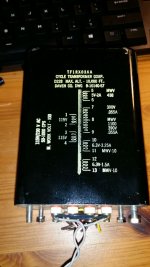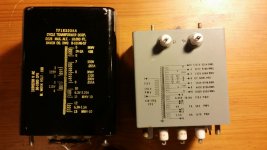I have before me a rather hefty transformer that I scored for cheap and one that I'd like to use in a tube project. It is a Daven Co. Transformer purportedly used in Naval equipment.
The secondaries are rated for 5V@2A (presumably for the rectifier heater), 390-0-390@55mA (plate supply), 6.3V@3.25A and 6.3@1.5A (for heaters). That should be plenty for my needs. However, each secondary has a "MWV" rating as well. For example, each of the heater windings state "MWV-10," which I can only assume a maximum working voltage of 10V. However, the numbers just don't add up for me. Presumably this is the voltage between the windings and the (grounded) case. In that case 10V seems pretty abysmal, and would preclude elevating the heater to, say, 100V for any tubes with cathodes that are not a ground potential.
Did I screw the pooch on this one, or did the great elder of yore mean something else by "MWV"?
The secondaries are rated for 5V@2A (presumably for the rectifier heater), 390-0-390@55mA (plate supply), 6.3V@3.25A and 6.3@1.5A (for heaters). That should be plenty for my needs. However, each secondary has a "MWV" rating as well. For example, each of the heater windings state "MWV-10," which I can only assume a maximum working voltage of 10V. However, the numbers just don't add up for me. Presumably this is the voltage between the windings and the (grounded) case. In that case 10V seems pretty abysmal, and would preclude elevating the heater to, say, 100V for any tubes with cathodes that are not a ground potential.
Did I screw the pooch on this one, or did the great elder of yore mean something else by "MWV"?
Attachments
I think you are right; MWV means max working voltage. Heater elevation was not commonly used in the valve era, as people assumed (rightly) that valves would have good heater-cathode insulation. Modern valves are often not so good in this area, which is why heater elevation is more popular now.
Perhaps as compensation for this restriction, you can at least use it at up to 10,000ft altitude!
Perhaps as compensation for this restriction, you can at least use it at up to 10,000ft altitude!
That's a shame. Most of the tubes I'm using should be fine but I wanted to have a voltage regulator tube where the cathode would be sitting at 300V. Might have to get a separate transformer for that one then. Although I would think even a wet noodle would have a better working voltage than 10V.
Maybe I should forgo a tube rectifier (10W for just the heater!). Are there any power tubes with a 5V heater? Before anyone goes on suggesting solid state regulators, I have decided to go with all glass purely for aesthetic. I deal with system efficiency as a day job, so why not live a little?
This transformer has a 50-1000 Hz input frequency, so should work just fine with 60Hz mains. I already made the mistake of buying a 400Hz transformer once, so made sure not to do it again. 400Hz is indeed very common on airplanes since you can make the transformers smaller, and therefore lighter.
For comparison here is a 400Hz transformer I have. Doing the math the aforementioned transformer has a ~63VA rating, while the 400Hz transformer has a ~190VA while being slightly smaller! Shame I can't use it though without going to extreme measures. Maybe build another amplifier to drive it?
Flux Density = EMF / (2*pi*f*N)
As frequency goes up, the flux density goes down, so you are less likely to saturate your core. Also the reason why SMPS transformers are so small.
Maybe I should forgo a tube rectifier (10W for just the heater!). Are there any power tubes with a 5V heater? Before anyone goes on suggesting solid state regulators, I have decided to go with all glass purely for aesthetic. I deal with system efficiency as a day job, so why not live a little?
Looking at one of the specs there, and I read somewhere that 400Hz mains is common on aeroplanes of a certain era.
This transformer has a 50-1000 Hz input frequency, so should work just fine with 60Hz mains. I already made the mistake of buying a 400Hz transformer once, so made sure not to do it again. 400Hz is indeed very common on airplanes since you can make the transformers smaller, and therefore lighter.
For comparison here is a 400Hz transformer I have. Doing the math the aforementioned transformer has a ~63VA rating, while the 400Hz transformer has a ~190VA while being slightly smaller! Shame I can't use it though without going to extreme measures. Maybe build another amplifier to drive it?
Flux Density = EMF / (2*pi*f*N)
As frequency goes up, the flux density goes down, so you are less likely to saturate your core. Also the reason why SMPS transformers are so small.
Attachments
- Status
- This old topic is closed. If you want to reopen this topic, contact a moderator using the "Report Post" button.

